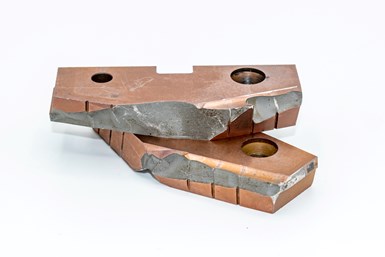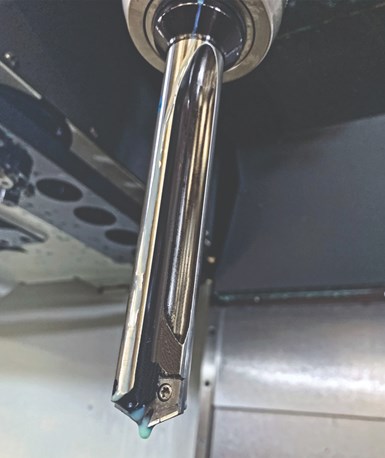Tips to Make CNC Machining Tool Failure Predictable
Appears in Print as: 'Tips to Make Tool Failure Predictable'
Accurate prediction of tool life is key to establishing a controlled, repeatable and reliable CNC machining process.
#techbrief
Edited by Derek Korn

Recognizing one’s machining limitations, in addition to simply being prepared, are key in predictive tool failure. Being more knowledgeable about an application, whether that is through data collection or proper training, enables shops to better establish the desired repeatability. (Photo credit: Allied Machine and Engineering)
Tool life is often a top priority when working in a high-production environment. To some extent, it is more important to use a tool that fails consistently and in the same manner than it is to have one that cuts faster. But, how can a shop achieve this? How can a shop proactively plan for predictable tool failure?
According to Allied Machine and Engineering, manufacturer of holemaking and finishing tooling systems, outside factors such as coolant, material hardness and machine maintenance can affect tool failure consistency. While it is unrealistic to hit 100% repeatability, it is key to keep as many factors as possible the same from job to job and part to part. Establishing repeatability makes it easier to prevent catastrophic failure that will damage the workpiece and tooling, which becomes much more expensive than just taking the tool out early even if that is before it is completely worn. Therefore, cost savings is one of the biggest benefits of consistent tool life. It is better to change an insert out ahead of time instead of pushing it to max life and potentially damaging components of the tool or components of the machine, causing more setup time and more machine downtime.
Featured Content
Here are some tips the company suggests to better achieve such a controlled process:
- Ensure proper coolant maintenance and filtration. From bacteria and machine lubricants to acidity and cutting debris, coolant contaminants can hinder the protective layer that coolant provides for both the material and the tool cutting edge. Whether using a refractometer to evaluate concentration levels or water test strips to measure pH levels, it is always less costly to maintain coolant than replace the entire system or risk tool damage.
- Perform preventive maintenance. To achieve consistent tool life, it is necessary to perform and keep a record of preventive maintenance of the machine tool components and fixtures. Vibration and reduced rigidity due to worn out components can be detrimental to new carbide tooling that shops are using.

Drilling systems such as the T-A Pro can use material-specific insert grades and geometries to best match the material being cut. (Photo Credit: Allied Machine and Engineering)
- Source materials from consistent vendors. Whenever possible, it is recommended to buy from the same tooling vendors because differences in materials cause tools to work differently. When sourcing from different vendors, monitor incoming mill-turn reports (MTR) to ensure chemical compositions are comparable and make the necessary changes to programs to prolong tool life.
- Focus on tool holders. With general-purpose machining, toolholders are typically not the driving factor leading to a reduction in tool life. Nevertheless, for consistent results at higher spindle speeds, it is necessary to have a balanced toolholder and assure the tool is assembled with minimal total indicator runout (TIR) in order to yield consistent, positive results. Regularly cleaning toolholders and machine spindles is also important because a layer of oil drying on these surfaces can increase overall TIR, which creates additional radial loads to the tools, and can cause failures and inconsistent results.
Aside from these top factors to consider when planning for predictive tool failure, it is also recommended to baseline tools. Whenever a part is being runoff for the first time, shops should monitor the first few tools to ensure that speeds and feeds are optimized, and repeatability has been established. This enables shops to determine the limit as to how many parts tools can machine before replacement.
Other aspects to consider include load limiters and part counters. For example, if one tool is consistently running at 80% load when load begins to steadily climb to the upper end, it is a sign that inserts are dull and need to be changed. That’s why load limiters are recommended. Part counters can also be integrated into part programs. By establishing a baseline as mentioned above, shops will know what the tool can do and then program the proper part count to signal a tool change into the machine.
Ultimately, not all shops are using or are capable of using predictive tool failure in their processes. However, collecting data and tracking tools is a good starting point. It is challenging to determine how long tools last or how to make them last longer if a shop is not tracking tool life or keeping a log. Knowing one’s limitations, in addition to simply being prepared, is key in predictive tool failure.
RELATED CONTENT
-
Measure 3D Parts Without Losing Time
This high-speed metrology and inspection system is said to process complex geometries faster than traditional inspection methods.
-
5 Facts About Thread Rolling
Unlike subtractive processes, thread rolling does not remove material but instead moves and molds ductile metals quickly and precisely into the thread form using a cold-forming process. Learn more about thread rolling and tooling advances here.
-
Getting Ready for Lights-Out Manufacturing
Lights-out manufacturing has the potential to save money while increasing capacity, but shops need the right equipment and to address potential challenges before implementing it.






